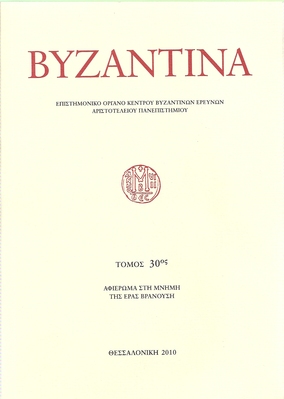Το επεισόδιο της θανάτωσης του αυτοκράτορα Ιουλιανού από τον άγιο Μερκούριο : θρύλοι και εικονογραφία
Part of : Βυζαντινά : επιστημονικόν όργανον Κέντρου Βυζαντινών Ερευνών Φιλοσοφικής Σχολής Αριστοτελείου Πανεπιστημίου ; Vol.30, No.1, 2010, pages 231-254
Issue:
Pages:
231-254
Parallel Title:
The slaying of the emperor Julian by st Merkurios : legends and iconography
Author:
Abstract:
An icon depicting the military St Merkurios slaying the Roman Emperor Julian is currently kept at the chapel of St Nicholas in the katholikon of Great Lavra. Mt Athos. However, although it originally dates back to 1630 (fig. 1). neither the legends that inspired this theme, nor the iconography itself are post-Byzantine interventions.In fact, the first attested legend giving the name Mâr Qur (Hellenized in Merkurios). one of the Forty Martyrs, dates back to the early 6th c. in the Syrian Novel of Julian. During the same century, John Malalas in his Chronicle (mid 6th c.) introduces St Basil in the incident, too; in this version. St Basil would encourage St Merkurios to kill the pagan Emperor. This were to become a dominant motif, which was to be repeated in one way or the other by a number of writers throughout the Byzantine literature (Chronicon Paschale where Christ is the inciter. John of Nikiu. John of Damascus who adds Virgin Mary as inciter. pseudo-Amphilochios and Michael Glykas who does not name the slayer). However other minor variations to the main legend had already emerged: the Armenian Faustus of Byzantium (end of 4th c.) attests Sts. Sergios and Bakchos exhorted by St Thekla; Sozomenos (mid 5th c.) attests two anonymous people (Apostles or Prophets); and finally Nikephoros Kallistos Xanthopoulos (14th c.) suggests the names of Saints Artemios and Merkurios. Such representations are common in Byzantine hagiography: warrior Saints (George. Theodoroi, Demetrios etc), empowered by a divine or sanctified figure to execute a personal triumph on behalf of a community (Christians, citizens etc.) over a personified version of the Evil (a dragon, pagans, invaders etc).The same incident is illuminated in a narrative way in the Pr. gr. 510 (fol. 409v) (fig. 2) already during the late 9th century. Moreover, the iconographie type of mounted Merkurios slaying the pagan Emperor is often depicted in a number of representations in Coptic art dated between the 10th and 13th centuries (fig 3). In the Balkans the same iconographie type is to be found in: cod. Athos. Panteleimon 6, (fol. 242v), 11th c. on a wall-painting from the church of St Merkurios in Corfu. 1974-5, and on one more from Dragalevci (1475-1476) (fig. 4). The Cretan School of the early post-Byzantine painting invents the iconography of standing Merkurios trampling on the fallen body of Julian and slaying him. It is depicted in mainly portable icons: one from the M. Latsi Collection, early 15th c. (fig. 5); another from St Nicholas tou Girokomeiou in Ochrid, 16th c.; on a wall painting executed by Theophanes of Crete in the katholikon of St Nicholas Anapafsas, Meteora. 1527. (fig. 6); and. finally, in the refectory of the Dionysiou Monastery on Mt Athos. 1603 (fig. 7). Local workshops in Northern Greece adopt the Gretan model and alternate it according to taste and skill, e.g. in an icon from Berroia, end of 15th c. (fig. 8); on a wall painting from the church of Panagia Haviara in the same town, early 16th c. (fig. 9); on a wall painting in the church Christos sto Kastro on Skiathos island. 17th c. (fig. 10). Other post Byzantine representations from different cultural contexts add more characters to the narrative, e.g.: St Basil in an enamel from Moscow, 17th c. (fig. 14); St Catherine in an icon from M. Latsi Collection. 17th c.; or Mary Virgin in an icon kept in Leimonos Monastery on Lesbos island. 18th c. (fig. 15).Throughout centuries. Christian iconology fiercely fought the disputable pagan Emperor Julian, although his ruthless presence was just an interval of two years in the 4th century. His imagery figure haunted Christians and provided a first class topic for the evolution of visual polemics until the post Byzantine artistic production.
Subject (LC):
Notes:
Περιέχει 15 εικόνες, Το άρθρο περιέχεται στο αφιέρωμα στη μνήμη της Έρας Βρανούση, Συντομευμένη η εργασία και με τον ίδιο τίτλο ανακοινώθηκε στο Βυζαντινό και Χριστιανικό Μουσείο της Αθήνας. Βλ. Εικοστό Όγδοο Συμπόσιο Βυζαντινής και Μεταβυζαντινής Αρχαιολογίας και Τέχνης. Πρόγραμμα και Περιλήψεις Εισηγήσεων και Ανακοινώσεων. Αθήνα 16, 17 και 18 Μάίου 2008, Αθήνα 2008, σ. 86-87.




